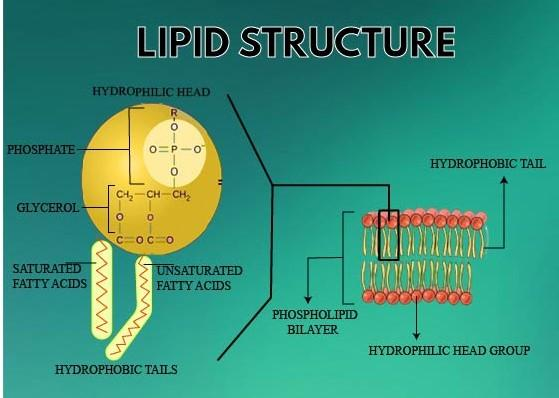
What elements makeup lipids?
Answer
517.2k+ views
Hint: A lipid molecule is a type of fat molecule that constitutes the half part of the human cells. They are insoluble in water and are very important while performing various functions in the body and also produce energy.
Complete answer:
Lipids are fat molecules that are insoluble in water but soluble in organic solvents like alcohol. They are the source of energy for the whole world and are found deep inside the ground. They naturally occur in the form of oil and help in the building of the cell membrane. They are made up of different elements that include carbon, hydrogen, and oxygen and may also contain nitrogen, and phosphorus. They are the major cause of certain illnesses that include rheumatoid, cancer, asthma, arthritis, Alzheimer's disease, and several inflammatory diseases.
Carbon is the most important element for the formation of lipids as it helps in the formation of the backbone of the lipid molecule. Hydrogen is the most simple and most abundant element present in the environment and helps in the formation of the lipid molecule. Oxygen is the most important element for the living organisms. When the two oxygen molecules are combined with some other elements then it will form a lipid. Nitrogen and phosphorus are not essential and are found in only a few lipid strictures but not all.
Lipids are classified into four major classes: fats, waxes, phospholipids, and sterols.
1. Fats: They are the fatty acids formed by glycerol and are called triglycerides. They may be solid or liquid at room temperature and when fats are liquid at room temperature then they are called oils while when they are solid at room temperature then they are called fats.
2. Waxes: They are made up of long hydrocarbon chains and are called organic compounds. Many of the waxes are made up of long chains of carboxylic acids and alcohols.
3. Sterols: They are formed by cholesterol with a basic structure like lathosterol, desmosterol, etc.
4. Phospholipids: their structure consists of various parts that include a phosphate group, diglyceride, and an organic molecule like choline. They also consist of nitrogen and phosphorus.

Note:
In the early 1800s, around 1786-1889 the lipids were first discovered by Michel Chevreul, who was the young scientist from France. The lipoproteins are made up of lipids and proteins when they are combined together, they were discovered in 1963 by Kare Berg.
Complete answer:
Lipids are fat molecules that are insoluble in water but soluble in organic solvents like alcohol. They are the source of energy for the whole world and are found deep inside the ground. They naturally occur in the form of oil and help in the building of the cell membrane. They are made up of different elements that include carbon, hydrogen, and oxygen and may also contain nitrogen, and phosphorus. They are the major cause of certain illnesses that include rheumatoid, cancer, asthma, arthritis, Alzheimer's disease, and several inflammatory diseases.
Carbon is the most important element for the formation of lipids as it helps in the formation of the backbone of the lipid molecule. Hydrogen is the most simple and most abundant element present in the environment and helps in the formation of the lipid molecule. Oxygen is the most important element for the living organisms. When the two oxygen molecules are combined with some other elements then it will form a lipid. Nitrogen and phosphorus are not essential and are found in only a few lipid strictures but not all.
Lipids are classified into four major classes: fats, waxes, phospholipids, and sterols.
1. Fats: They are the fatty acids formed by glycerol and are called triglycerides. They may be solid or liquid at room temperature and when fats are liquid at room temperature then they are called oils while when they are solid at room temperature then they are called fats.
2. Waxes: They are made up of long hydrocarbon chains and are called organic compounds. Many of the waxes are made up of long chains of carboxylic acids and alcohols.
3. Sterols: They are formed by cholesterol with a basic structure like lathosterol, desmosterol, etc.
4. Phospholipids: their structure consists of various parts that include a phosphate group, diglyceride, and an organic molecule like choline. They also consist of nitrogen and phosphorus.

Note:
In the early 1800s, around 1786-1889 the lipids were first discovered by Michel Chevreul, who was the young scientist from France. The lipoproteins are made up of lipids and proteins when they are combined together, they were discovered in 1963 by Kare Berg.
Recently Updated Pages
Master Class 12 Business Studies: Engaging Questions & Answers for Success

Master Class 12 Economics: Engaging Questions & Answers for Success

Master Class 12 English: Engaging Questions & Answers for Success

Master Class 12 Maths: Engaging Questions & Answers for Success

Master Class 12 Social Science: Engaging Questions & Answers for Success

Master Class 12 Chemistry: Engaging Questions & Answers for Success

Trending doubts
What is meant by exothermic and endothermic reactions class 11 chemistry CBSE

Which animal has three hearts class 11 biology CBSE

10 examples of friction in our daily life

One Metric ton is equal to kg A 10000 B 1000 C 100 class 11 physics CBSE

1 Quintal is equal to a 110 kg b 10 kg c 100kg d 1000 class 11 physics CBSE

Difference Between Prokaryotic Cells and Eukaryotic Cells




